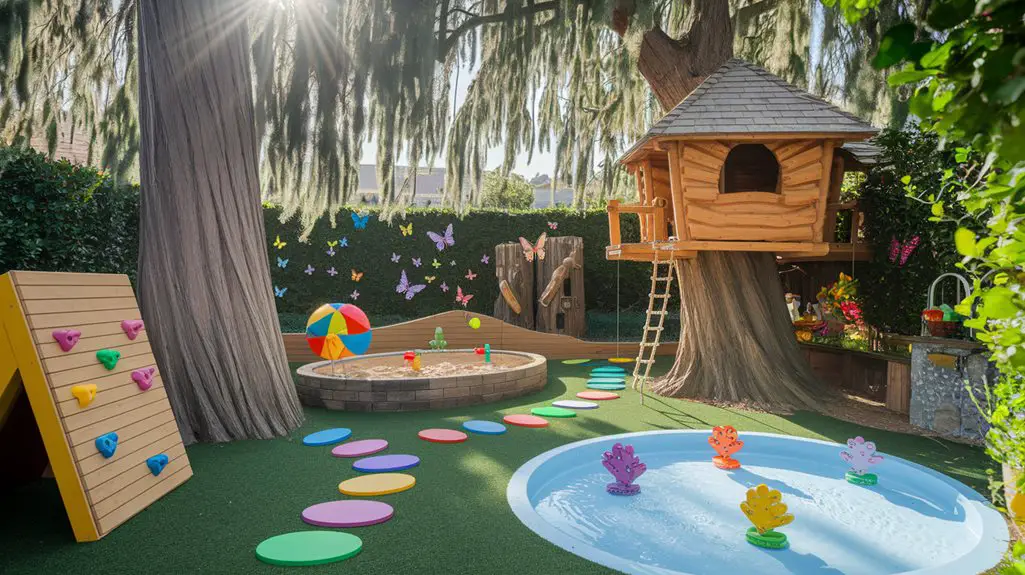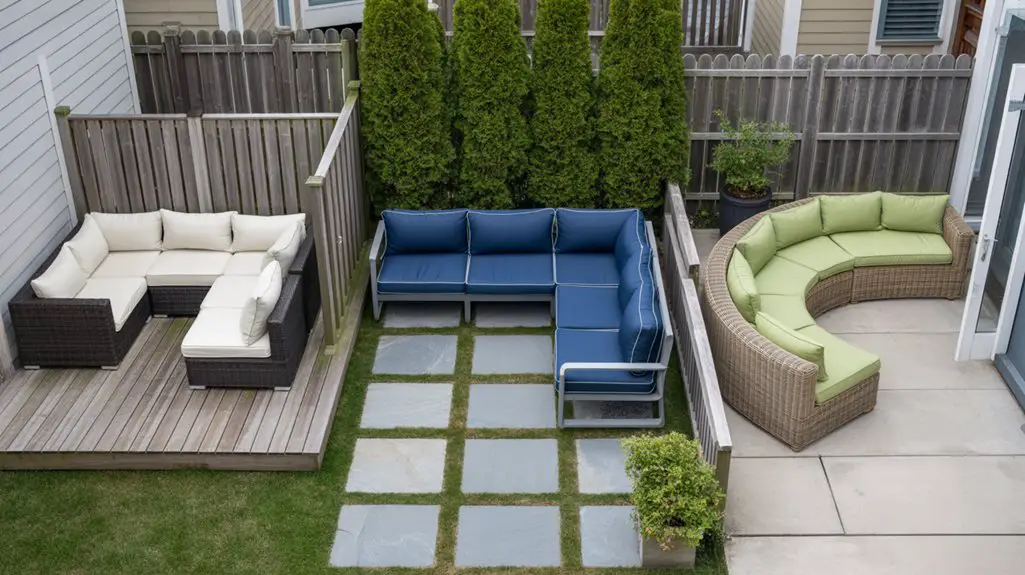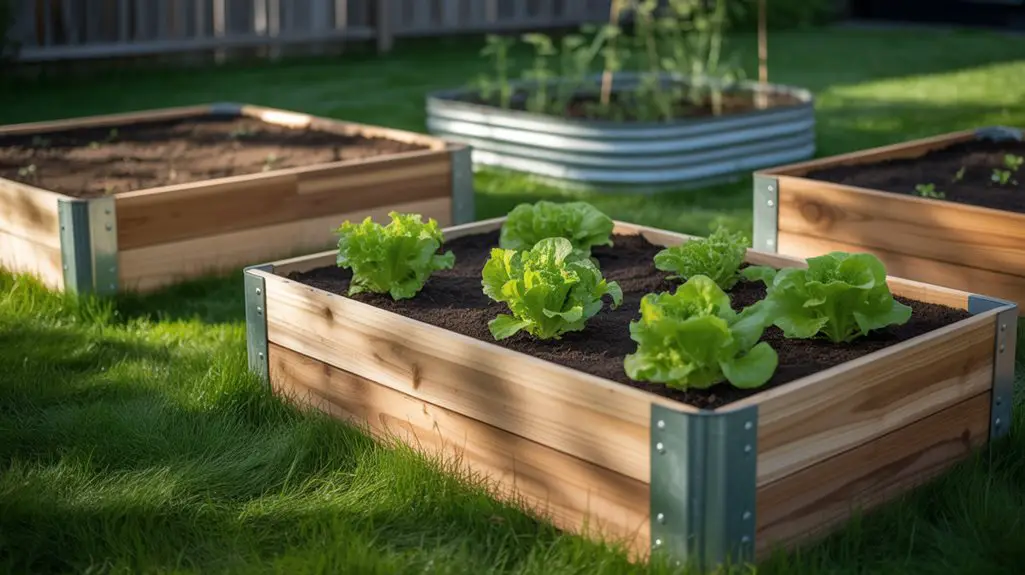Nearly 87% of child development experts agree that outdoor play spaces greatly enhance cognitive and physical growth compared to indoor-only activities. You’ll find that transforming your backyard into a thoughtfully designed children’s area doesn’t require extensive landscaping or expensive equipment. With strategic planning, natural elements, and creativity, you can create engaging environments that spark imagination while promoting healthy development. The following ideas will transform ordinary outdoor spaces into extraordinary childhood havens.
Natural Adventure Zones With Tree Stumps and Boulders
While traditional plastic playsets have their place, natural adventure zones constructed with tree stumps and boulders create multisensory play environments that encourage open-ended exploration and physical development. You’ll find these elements provide variable heights for climbing, jumping, and balancing—crucial activities for developing proprioception and core strength. Arrange stumps at different elevations (4-18 inches) in stepping-stone configurations, ensuring they’re firmly secured in the ground with flat tops for safe footing. Select boulders with rounded edges and embed them partially for stability. Consider incorporating a mix of textures: smooth river rocks for tactile stimulation and rough-hewn logs for grip development. Position these elements to create natural circuits that challenge children’s motor planning abilities while blending aesthetically with your landscape’s existing features. Additionally, integrating obstacle courses for kids can further enhance their physical skills and provide endless hours of fun.
DIY Obstacle Courses for Physical Development
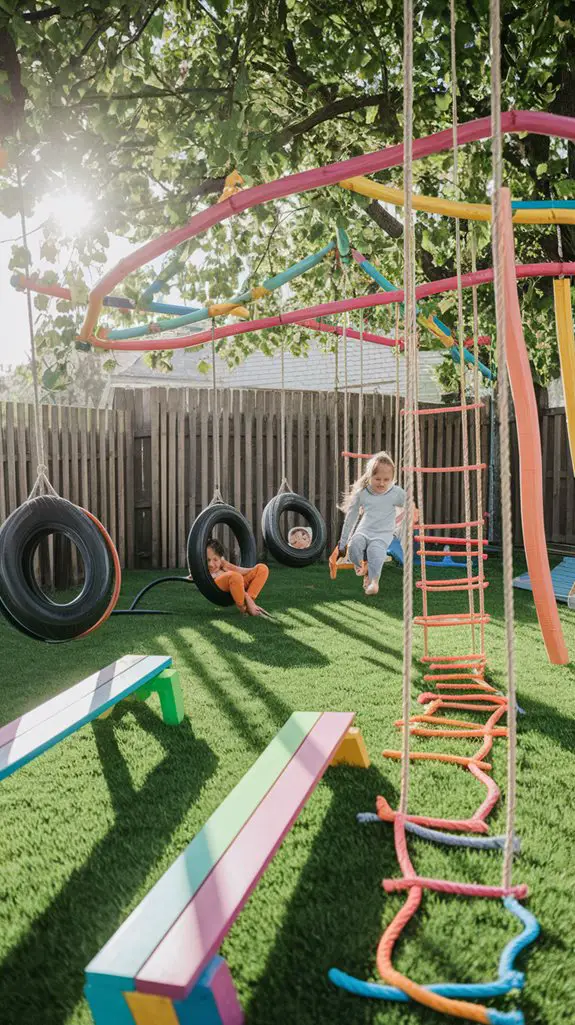
DIY obstacle courses transform ordinary backyards into dynamic training grounds where children develop fundamental motor skills through structured physical challenges.
You’ll need minimal materials to create stations that enhance balance, coordination, and strength while maintaining safety standards.
Design your course with progressive difficulty using:
- Balance elements – Connect wooden planks between cinder blocks at varying heights, install stepping stones in zigzag patterns, or secure a thick rope to posts for tightrope walking.
- Climbing challenges – Attach climbing holds to fence panels, create tire pyramids, or install cargo nets between trees.
- Agility stations – Set up hurdles using pool noodles, create weaving courses with garden stakes, or establish timing stations for sprints.
Reconfigure components regularly to maintain engagement and target different developmental goals. Incorporating backyard playground equipment can also add variety and enhance the play experience.
Weather-Proof Play Stations for Year-Round Fun
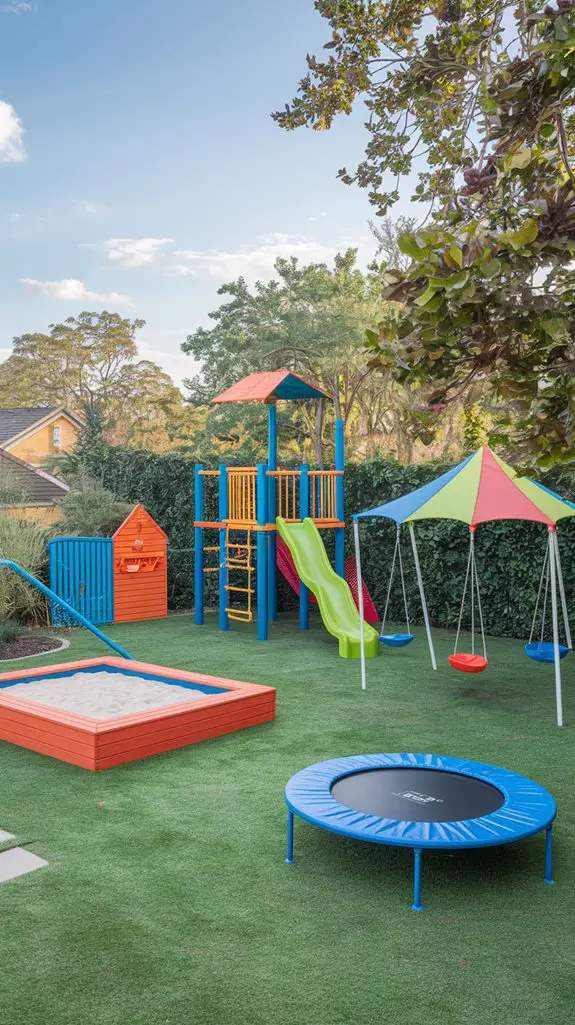
Because seasonal changes often limit outdoor play opportunities, weather-proof stations guarantee children maintain access to developmental activities regardless of environmental conditions.
Consider installing covered pavilions with removable side panels that provide shade during summer months and protection from wind and rain during inclement weather.
Integrate waterproof storage solutions containing seasonal activity kits beneath benches or within weather-resistant cabinets. You’ll maximize functionality by incorporating adjustable features: retractable canopies, UV-resistant materials, and proper drainage systems.
Select composite decking or rubberized surfacing that won’t become slippery when wet or excessively hot in direct sunlight. Position stations strategically to capitalize on natural windbreaks and sun exposure patterns.
For thorough protection, install rain gutters on structures to direct water away from play zones, maintaining dry, usable spaces year-round.
Sensory Gardens With Child-Friendly Plants
Sensory gardens designed specifically for children offer multisensory learning experiences through carefully selected plant varieties that engage all five senses while maintaining safety standards.
When creating your child’s sensory garden, prioritize non-toxic species that stimulate curiosity through texture, scent, and color.
- Tactile Plants: Include lamb’s ear (Stachys byzantina) for its velvety leaves, ornamental grasses that rustle in the breeze, and smooth-barked trees like birch that children can safely touch.
- Aromatic Varieties: Plant lavender, mint, and lemon balm at child height—these release scents when gently rubbed between fingers.
- Visual Stimulants: Incorporate sunflowers, rainbow chard, and butterfly bush to attract pollinators while providing vibrant colors throughout growing seasons.
Position these plants along wide, navigable paths that accommodate children’s movements while exploring their sensory environment. Additionally, consider creating a frog-friendly oasis in your garden to enhance the ecosystem and further engage children with nature.
Creative Mud Kitchens and Water Play Areas
Natural elements like mud and water provide exceptional developmental benefits when incorporated into dedicated play zones within your backyard landscape.
Design your mud kitchen using repurposed wooden pallets or weather-resistant cabinetry, equipped with stainless steel or plastic bowls, utensils, and measuring cups.
Position your water play area on permeable surfaces—consider installing a recirculating pump system to minimize water waste and prevent stagnation.
Incorporate vertical elements such as water walls with funnels, tubes, and water wheels to demonstrate scientific principles of gravity and flow.
For safety, maintain shallow water depths (under 2 inches) in play tables, install proper drainage, and establish clear visibility from adult supervision areas.
Choose non-toxic materials throughout, and implement a seasonal maintenance schedule to prevent bacterial growth during warmer months. Engaging in exciting backyard games can further enhance the overall fun and physical activity for children in these play areas.
Secret Hideaways and Reading Nooks
Creating dedicated spaces where children can retreat into their imaginations serves as a fundamental component of a well-designed play area.
These secluded nooks provide children with a sense of ownership and privacy while encouraging literacy and independent play.
You’ll need to take into account the following when designing your hideaway:
- Structural integrity – Use weather-resistant materials like cedar or treated lumber for permanent structures, or repurpose items like teepees, canopies, or playhouses for temporary options.
- Comfort elements – Add waterproof cushions, all-weather rugs, and soft pillows to create inviting reading spaces.
- Personalization features – Install small shelves for books, battery-operated lights for evening use, and decorative elements that reflect your child’s interests.
Positioning these nooks under mature trees provides natural shade and enhances the magical ambiance. Additionally, consider incorporating interactive features that can further engage children and spark their creativity during playtime.
Customizable Play Structures That Grow With Your Child
While hideaways offer intimate spaces for imagination, investing in adaptable play structures represents a smart long-term approach to backyard play design.
Look for modular systems with components that can be reconfigured as your child develops new skills and interests.
Select structures featuring adjustable heights for platforms, interchangeable accessories, and expandable elements.
Today’s market offers models with removable climbing walls that can be reinstalled at steeper angles, swing beams that accommodate everything from toddler buckets to athletic rings, and slide attachments with variable heights.
Consider weight capacities and durability factors when purchasing.
Opt for materials like pressure-treated lumber, marine-grade plywood, or powder-coated steel that withstand weather exposure.
Many premium systems offer conversion kits that transform jungle gyms into teen-friendly spaces with hangout decks and study platforms. Additionally, incorporating engaging play area layouts can further enhance the play experience and encourage creativity.
Conclusion
Creating a dynamic children’s play area is an investment that’ll pay dividends in your child’s development. By incorporating these seven diverse elements, you’ve crafted a backyard that’s more than just a playground—it’s a canvas where young imaginations can soar like eagles. Balance safety with adventure, sensory stimulation with quiet reflection, and watch as your outdoor space transforms into the epicenter of childhood discovery and growth.

